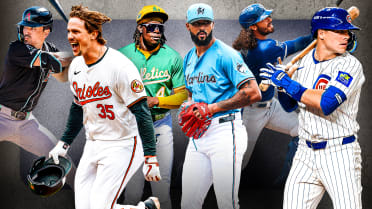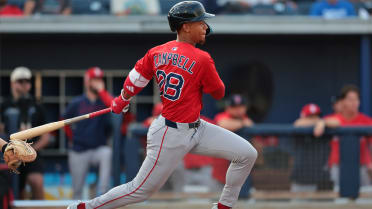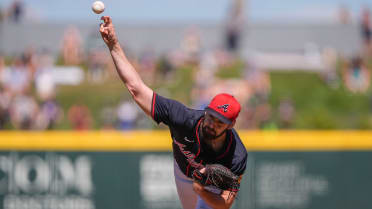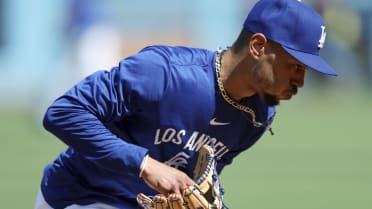Justin Verlander and Gerrit Cole's Triple Crown numbers paint in broad strokes. Their ERAs and strikeout totals this season reflect how they've fully unlocked their ace-level stuff in an Astros organization that has assembled a pitching staff for the ages.
But when you look deeper, at the specific type of poor contact they're getting from hitters, you get a window to a fundamental change both Verlander and Cole made when they came to Houston: prioritizing four-seam fastballs and deemphasizing two-seam fastballs.
"I stopped throwing my two-seamer," Verlander said. "I know I'm extremely efficient at throwing a four-seamer. I stay behind it probably better than anybody else, or just about. One of the things that was explained to me when I got here was, my two-seamer is basically just an ineffective four-seamer. So why would I throw it? I'm basically just doing guys favors."
The change works for both Verlander and Cole because their fastballs profile similarly. They have, as Verlander terms it, "hop."
"Just because you throw hard doesn't mean you have our profile," Verlander said. "[Cole] is somebody who has good four-seam hop, and that plays well. You can't lump everybody in and say, 'Oh, OK, you throw hard, you should throw fastballs at the top of the zone.' It doesn't work like that. But [the Astros] identified him very similarly to what they did with me -- like, 'You're basically doing guys favors trying to throw them two-seamers at the bottom of the zone.'"
How do they know it's working? Not just by the swings-and-misses (Verlander has a Major League-best 134 on four-seam fastballs, and Cole ranks 10th with 95), but by the balls in play. Verlander and Cole are generating a ton of weak fly balls and popups.
Statcast classifies all batted balls, based on exit velocity and launch angle, into either productive or unproductive categories of contact. As Astros, Verlander and Cole have had a huge jump in the number of poorly-hit balls they've induced in the "Under" category -- air balls that don't do damage.
Verlander and Cole's rate of "Under" contact induced, 2017 vs. '18
Verlander
2017 -- Tigers: 29.6%
2017 -- Astros (incl. postseason): 39.6%
2018: 44.8% (highest among SP)
Cole
2017: 22.6%
2018: 29.9%
On batted balls classified as "Under," opposing hitters have a combined .034 batting average against Cole and Verlander this year: 3-for-63 against Cole, 3-for-111 against Verlander. And it's mainly their four-seamers that are getting those results.
"I'm doing something to get that kind of contact -- I'm throwing more four-seamers, attacking the top half of the zone better," Cole said. "It wasn't, like, attacking that specific outcome. It's just proof in the pudding.
"Every player's profile is different. [The Astros] are just trying to highlight what you do well. Maybe they chase four-seamers, I don't know. But as far as I'm concerned, they just highlighted what my strengths were. And that's how I've crafted my approach."
Highest rate of "Under" contact on 4-seamers, SP, 2018
Min. 50 batted balls vs. 4-seamer (95 starters)
1) Justin Verlander: 50.9%
2) Matthew Boyd: 47.7%
3) Gio Gonzalez: 47.1%
4) Jhoulys Chacin: 45.1%
5) Gerrit Cole: 44.8%
Having Verlander already in Houston when he got there helped Cole tremendously, giving him someone with whom he could break down the craft of pitching, who had already bought into the Astros' suggestions and experienced brilliant success.
"I specifically remember talking to him about what we were trying to get out of the four-seam," Cole said. "Just understanding the type of action that I wanted. That was new."
Verlander has long been the king of the high fastball; Cole calls it "one of the best four-seamers of all time." Statcast helps show one of the reasons for the electricity of that pitch: Elite spin rate. High-spin fastballs tend to get more swings-and-misses, especially when elevated. The spin creates the "rising fastball" effect, as the ball defies gravity slightly longer.
Highest avg. 4-seam spin rate, SP, 2018
- Garrett Richards: 2,606 rpm
2) Justin Verlander: 2,604 rpm
3) Yu Darvish: 2,542 rpm
4) Tyson Ross: 2,519 rpm
5) Mike Minor: 2,511 rpm
Avg. 4-seam spin rate for SP: 2,246 rpm
In addition to whiffs, high-spin four-seamers also produce more balls in the air, as hitters swing under the ball. Sometimes, that means high-spin fastball pitchers can be hurt by the home run. But Verlander's four-seamer is so good that, for him, air contact often just means popups.
Popups, essentially, act as strikeouts. They're automatic outs, and runners can't go anywhere. Verlander has gotten even more of them since he stopped throwing two-seamers with Houston. The same has gone for Cole as he's adopted the four-seam-first approach. With elevated four-seamers, they get more popups with less damage.
"My two-seamer was a popup pitch as well," Verlander said. "It just was less effective, more likely to get barreled."
Verlander has gotten 37 popups this year, most of any pitcher, and 27 have been generated by his four-seamer, the most of any four-seam thrower. Cole has gotten 23 popups, 15 on four-seamers. Their popup rates have increased significantly with Houston.
Verlander and Cole's popup rates, 2017 vs. '18
Verlander
2017 -- Tigers: 9.7%
2017 -- Astros (incl. postseason): 14.5%
2018: 14.8%
Cole
2017: 7.6%
2018: 10.9%
"Weak popups are more effective than groundouts. Weak popups turn into outs more often than anything else," Verlander said. "I've always been a fly-ball guy. I don't get a lot of ground balls. I never have. So why not just embrace it?"
Cole's four-seamer doesn't have the same spin rate as Verlander's (although he has increased his average four-seam spin from 2,156 rpm with the Pirates in 2017 to 2,338 rpm with the Astros in '18). That's likely a factor in why Verlander's popup numbers are more extreme. Still, when Cole joined the team, Verlander saw the same life in Cole's fastball that he had in his. He helped Cole see that for himself, and act on it.
"He found out that he had good four-seam hop, and he didn't really know how to use it," Verlander said. "[In Spring Training] we were playing catch, and I was pointing out the ones that were good and the ones that were bad. And they were basically the opposite of what he thought."
Cole was targeting his throws where his normal two-seam action would make the ball run back to the center of Verlander's body. But not all his throws were running. And the ones that didn't run -- that hit Verlander in the right shoulder and not the chest -- were the ones Verlander was highlighting.
"To me, it seems like I'm yanking the ball," Cole said. "But to him, he's like, 'You're actually staying behind the ball and getting better rotation. It's actually doing what you want it to do. It's not fading, it's jumping.' I took that trajectory and moved it to my spots. Trying to chase that type of action, that was a big day for me."
Once he knew what he was looking for, Cole could implement the changes in his pitch repertoire, and get the repetitions needed to breed improvement.
"When you're spinning a two-seam, getting on the side of the ball to get more run or sink can be good, but it can really be detrimental to your four-seam," Cole said. "Especially when you're throwing both back and forth as much as I was -- and probably, even in my mind, using the two-seamer as the No. 1 fastball. Cleaning up that lack of the definition between the two, and then leaning on the four-seam, having it become my primary fastball over my two-seam, it's just benefited me as a whole."
Now, Cole's contact profile, like Verlander's, is undergoing the corresponding shift to the air. Cole's ground-ball rate has dropped more than 10 percent from 2017 to '18, down to 36.5 percent -- near Verlander's 30.8 percent, among the lowest for starting pitchers. That contrasts the Astros' other starters -- Dallas Keuchel, Lance McCullers and Charlie Morton -- three of the league's heaviest ground-ball generators. But Verlander and Cole have the fastballs to make their approach extremely effective. The proof's in the pudding.
"I don't think you can generate hop," Verlander said. "When you have it, you can work on it. If you've got it naturally, you can learn how to use it."
David Adler is a reporter for MLB.com based in New York. Follow him on Twitter at @_dadler.



